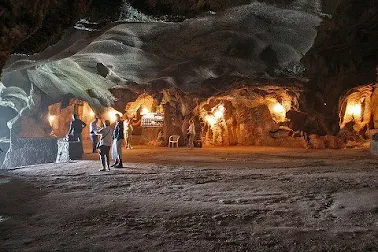Hercules Cave – A Legendary Wonder of Tangier, Morocco
🌍 Introduction: Where Nature Meets Mythology
Nestled near the dramatic cliffs of Cape Spartel, just 14 km from Tangier, the Caves of Hercules (مغارة هرقل) are one of Morocco’s most fascinating tourist attractions. This site combines stunning natural beauty, deep mythology, and intriguing history — a place where legend and landscape come together.
🧭 Location and How to Get There
-
Distance from Tangier: About 20 minutes by car (14 km)
-
Coordinates: Near Cape Spartel, where the Mediterranean Sea meets the Atlantic Ocean
-
Transportation:
-
🚌 Public transportation is limited
-
🚖 Taxis or rental cars are the most convenient options
-
🚶♀️ Some visitors enjoy biking or walking parts of the coastal route
-
🪨 The Cave’s Natural and Geological Features
🌊 Two Entrances – One Iconic View
-
Sea-facing Entrance: Famous for its shape that resembles the map of Africa — a popular photo spot.
-
Land-facing Entrance: Provides easier access for visitors entering from the road.
⛰️ Limestone Formation
The cave is carved into soft limestone, shaped over centuries by water erosion and human use. Some parts were historically quarried by the Berbers to create millstones.
🏺 A Place of History and Culture
📜 Ancient Human Use
-
Archaeological findings show human activity since the Neolithic period (over 6,000 years ago).
-
Berbers, Phoenicians, and Romans likely used the cave for shelter or trade.
🏛️ Modern Preservation
-
Opened to the public in 1920
-
Declared a national heritage site in 1952
-
Equipped with electric lighting in 1982 for safer tourism
🦸♂️ Mythology: The Legend of Hercules
The cave’s fame isn’t only due to its geography — it’s the center of legendary tales:
-
According to Greek mythology, this is where Hercules (Heracles) rested during his 12 Labors, especially before his 11th task to retrieve the golden apples from the Garden of Hesperides.
-
Some legends say Hercules used his strength to separate Africa from Europe, creating the Strait of Gibraltar.
✨ The cave’s position facing the sea, with its “Map of Africa” opening, supports its mythical and symbolic connection to ancient tales.
📸 Top Things to See and Do
🔭 Must-See Highlights
-
“Map of Africa” Opening – The most photographed spot
-
Panoramic Views – Spectacular vistas of the Atlantic Ocean
-
Cave Walls – Eroded textures and small tide pools
-
Nearby Attractions – Visit Cape Spartel Lighthouse just a few minutes away
🛍️ On-Site Amenities
-
Local souvenir shops
-
Parking area
-
Small cafes or vendors nearby
📅 Best Time to Visit
-
Spring and Autumn: Mild temperatures, fewer tourists
-
Summer: More visitors, but great for ocean views
-
Weekdays: Less crowded than weekends
-
Early morning or sunset: Best times for photography and lighting
📝 Travel Tips for Visitors
-
👟 Wear comfortable shoes – the cave floor is uneven
-
💧 Bring water and sun protection, especially in summer
-
🎒 Avoid bringing large bags, as space can be tight inside
-
📷 Charge your camera – the photo opportunities are unique
-
🧼 Respect nature – don’t litter or damage rock surfaces






0 Comments